Volleys are a key part of many racket sports, but this is especially the case in padel! Because padel is played on a relatively small court surrounded by walls, and because the lob is such a popular shot, there are many occasions where you’ll be called upon to hit volleys in a variety of different ways. Some players are great at hitting them, and some players definitely aren’t!
When I first started playing padel I definitely fell into the category that wasn’t great at hitting them, but I quickly realised that it was something I needed to work on if I was going to be a decent player. Trust me, there’s nothing more annoying for you and your partner than when you have an amazing opportunity to hit an aggressive volley and you completely mess it up! Therefore, it’s up to all of us to do our best to avoid those situations!
When you hit a volley for the first time, you’ll immediately notice that the ball is much harder to hit accurately than when you’re hitting a shot after it’s bounced. The increased difficulty of the volley means that you’ll have to work much harder in order to perfect them compared to most normal shots, and that’s what I’m aiming to help you with in this post!
Here are 12 tips that will help you to improve your volleys in padel:
- Keep your eyes on the ball at all times
- Get your racket into a good hitting position early
- Move your feet fast to get underneath the ball
- Work on your shot selection
- Learn to target different areas of the court
- Put the correct foot forward
- Apply spin to the ball
- Keep your wrist locked – especially when the ball is moving fast
- Practice your forehand and backhand volleys equally
- Practice specific in-game scenarios
- Vary the pace of your shot
- Consider allowing the ball to bounce in certain scenarios
In the rest of this post we’ll go through each tip in ore detail so that I can explain exactly how each one is going to help you improve your volleys! Let’s get started!
Keep Your Eyes On The Ball At All Times
This first tip is fairly simple, but it’s also probably the most important one. Basically, you will be much more effective at hitting volleys if you keep your eye on the ball as it’s travelling through the air and watch it all the way on to your racket.
It’s much easier to hit shots accurately when we’re looking at the ball. This is because it allows our eyes to detect exactly where the ball is, and as a result we can move our racket to that location to strike it. If you take your eye off the ball while it’s in flight and start to look elsewhere, your brain will not be 100% sure on the exact location of the ball. This can lead to you being less accurate as you move your racket towards the ball, and can cause you to miss your shot entirely!
I’m always amazed at how many players overlook this aspect of their hitting technique. Simply training yourself to keep your eyes on the ball a lot longer can have a dramatic impact on your level of play. When you practice, try to keep reminding yourself to watch the ball intently. If you do this consistently in practice it will slowly become second nature to you and you’ll find yourself hitting volleys a lot more sweetly.
Get Your Racket Into A Good Hitting Position Early
When playing sport, it’s always a good idea to get your body (and more specifically, your racket) into a position from which it is easy to hit the ball. If your opponent strikes the ball powerfully towards you and your racket arm is down low by your side, it will be very tough for you to react quickly enough to return the ball accurately. This is because it takes longer to move your racket arm up from a low down position.
If you racket arm is in a position like the one shown below, or around about chest height, this will make it much easier for you to react quickly and volley the ball. This is because your arm is in an active position, ready to strike, and is at the approximate height that the ball will reach you. This means your arm probably won’t need to move as far before it connects with the ball! Practice getting into positions like this regularly and make it a habit – especially when playing close to the net!
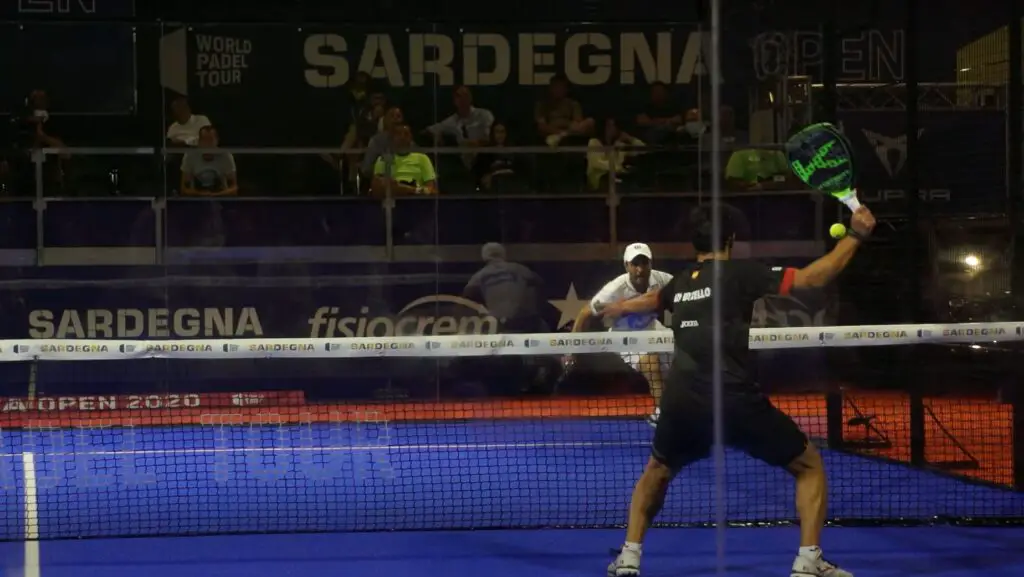
Move Your Feet Fast To Get Underneath The Ball
Good footwork is also a vital aspect of volleying well in padel, especially when you’re volleying balls that have been lobbed and are dropping down from above your head. To put it simply, if you don’t move your feet correctly, you won’t get your body in the correct position to hit the volley. Moving your feet inaccurately could lead to you getting too close to where the ball is dropping, and as a result you won’t have enough room to swing your racket arm and make contact with your racket. You could also fail to get close enough to the ball, meaning that you have to stretch or lunge to hit the volley. This can lead to unforced errors and will also mean that you don’t get as much power on your shot as you would like.
So, when you see the ball go up in the air, move quickly into the zone where the ball is dropping and keep your eyes fixed on it. Make sure you position your body so that you have enough space to swing the racket, and you should be in an excellent position to hit a good shot.
Work On Your Shot Selection
There are many different types of volley in padel, and some of them should only be used in certain moments or from certain areas on the court. To improve the success rate of your volleys, you should aim to learn the situations in which it is more appropriate to use each one.
For example, the topspin smash is a volley that is best to play when you’re in a relatively central position on the court, a few metres away from the net. The flat smash volley is suitable for using when you’re very close to the net and your opponent gives you an easy chance to punish their shot. Volleys like the Bandeja are played from much further back on the court when it’s harder to play aggressive shots due to your distance from the net. A volley like the Gancho is most often used when the ball is looping up over your non-racket shoulder and you need to quickly ‘hook’ the ball back towards your opponent before it gets past you.
Through experience during matches and during practice, you will slowly begin to know when certain volleys are usable and when they are not. To enhance your understanding, I’d also recommend watching plenty of professional padel matches so that you can watch and learn when the most elite players use each of the different volleys. The more you understand this, the better your shot selection will be, meaning you make less mistakes and win more points as a result.
Learn To Target Different Areas Of The Court
Some padel players (especially beginners) can forget that when volleying, placement is often just as important as power. I see a lot of newcomers to the game hit their volleys straight down the middle of the court, and while this can be a good tactic, it’s also important to vary the direction of your volleys. Mixing things up in this way means that your opponent’s will never truly be able to predict where your volleys are going to be directed, which stops them pre-meditating their returns.
If you want to get more comfortable directing your volleys to different parts of the court, I’d recommend using one of the drills popularised by the Bryan brothers – a famous tennis duo. If you want to perform the drill, follow the steps below:
- Yourself and a partner should each have a padel racket, and should stand opposite each other with about 5-10 metres in between you. If you’re on a padel court, both players should stand mid-court on opposite sides of the net to one another. The position of each player should look something like the diagram below!
- Your task is to volley the ball between you, whilst moving laterally side to side. Both players should start by moving to their left whilst hitting the ball to one another. Then, once they reach a certain point, both players should start moving to their right, volleying the ball to each other whilst crossing in the middle of the court.
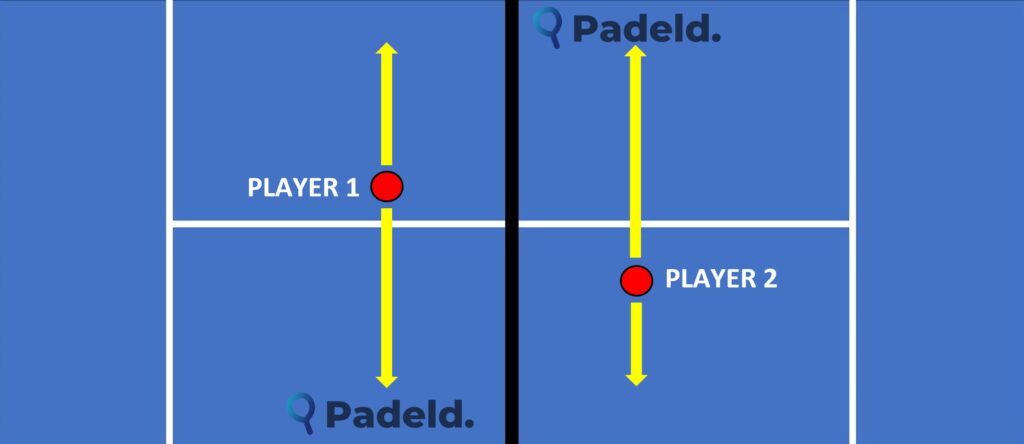
This type of drill helps you get comfortable with hitting volleys at different angles, which will come in handy when you need to target different areas of the court to put your opponents under pressure during matches.
Put The Correct Foot Forward
As we’ve already discussed a few sections ago, displaying good footwork and moving your feet accurately is key to playing good volleys in padel. Not only should you be fast on your feet to get close to the dropping ball, but in most cases you should also try to ensure that you place your ‘best foot forward’ whilst playing your shot. This often allows you to maintain a better body position when hitting your volley.
So, what do I mean by placing your best foot forward? Basically, you should always try to ensure that when playing a volley, you step forwards with the foot that will allow you to remain balanced and transfer your weight into the shot most effectively. When playing a forehand volley, it is often most beneficial to step forward with your opposite foot. So, if you are a right handed player playing a forehand, you should step forwards into the shot with your left foot. Left handed players should step forward with their right foot. However, when hitting a backhand volley, you should most often be trying to step forward with the same foot. So, a right handed player hitting a backhand volley should step forward with their right foot, with the opposite being true for left handed players.
Of course there are occasions where you won’t be able to step into your shot in this way. Sometimes we are late to the ball which doesn’t allow us to do this, and sometimes due to our body position on court it will feel more natural to step forwards with the other foot. However, this tip is definitely worth bearing in mind as it will no doubt increase your sense of balance and power.
Apply Spin To The Ball
Some volleys are more effective when you apply spin to your shot, rather than just hitting the ball ‘flat’ and applying no spin.
Padel beginners will tend to hit every single volley the same way, simply hitting through the ball rather than worrying about what kind of spin they can apply to their shot. This is a perfectly reasonable approach to take when you’re first getting comfortable with the sport and hitting the ball. However, as you gain more experience, you will want to start developing your ability to apply spin. This makes it easier for you to hit winning shots, and makes it harder for your opponent to reach them too.
Take the smash shot for example. If you’re playing the smash volley from close to the net, you can make it a lot more effective by rotating your racket over the top of the ball as you hit it. This rotation of the racket as you strike the ball applies top spin to the ball, which causes it to ‘kick’ upwards when it hits the ground and the back glass. Using top spin is a great way to cause the ball to bounce out of the court over the side wall, which is exactly what you should be aiming to do when hitting smashes from around mid-court.
Alternatively, applying backspin to some of your volleys by ‘undercutting’ the ball (click here if you’re not sure what I mean by that) is another very effective padel technique. This slows the ball down as it comes off the court, which can cause your opponent to misjudge the bounce and also gives them no pace to work with on their resultant shot.
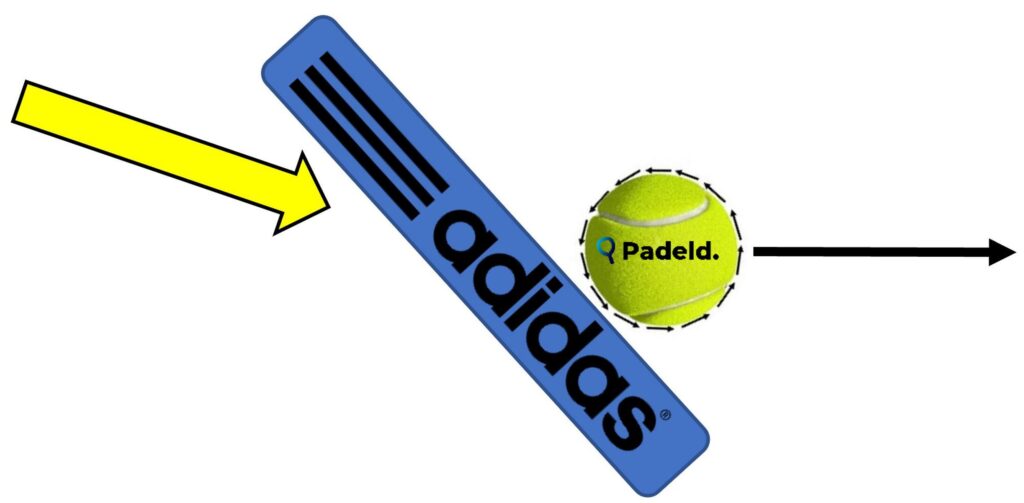
So, once you’re comfortable hitting ‘normal’ volleys, use your practice sessions to get comfortable with what it feels like to apply spin. If you practice this enough, you’ll be able to do it much more reliably during actual matches – which should be the goal for everyone!
Keep Your Wrist Locked – Especially When The Ball Is Moving Fast
If you’re in the middle of a point and you find yourself standing close to the net, there’s an excellent chance that one of your opponents will put plenty of power on the ball and try to hit it past you. In this situation, it’s often a good idea to play a volley so that you can immediately deflect the ball back onto your opponent’s side of the court. When the ball gets hit towards you at a decent speed, it’s important to maintain a strong wrist if you want to hit an accurate volley in return. If you don’t maintain a strong wrist in this scenario, the force of the ball hitting your racket could cause your hand and your racket to be pushed backwards, meaning that your volley will probably end up being wildly inaccurate.
If you can keep your wrist strong and locked throughout the motion of the shot, then the ball is much more likely to go where you want it to.
Practice Your Forehand And Backhand Volleys Equally
This tip is fairly self explanatory! If you want to be able to volley effectively, then you’ll need to practice your backhand volleys just as much as you practice your forehand volleys.
Yes, forehand volleys are a lot more fun to practice hitting, but there are some times during a match where you’ll have to resort to the backhand instead. In these situations, you need to ensure that you’re good enough to do so, and the only way to achieve that is through practice!
Practice Specific In-Game Scenarios
As we’ve already covered, it’s vital that you spend time practicing your volleys through either dedicated practice sessions, or matches against opponents. A great way to practice volleys specifically is to simulate certain in-game scenarios, so that you can really get a feel for what it is like to hit volleys during certain moments of a match and from varied positions on the court.
All you need to practice in this way is a padel court, a racket, a partner and some balls. Once you have all of those, you can decide which of the game situations you would like to practice.
I find that a good way to start is by positioning yourself a couple of metres away from the net and asking your partner to throw some balls up in the air above your head. Your only task during this drill is to volley the ball once it drops low enough to strike.
I would recommend practicing lots of different kinds of volleys using this method. Make sure you practice flat smashes and top spin smashes, and work on your ability to get the ball to bounce over the side wall of the court. In addition to the smashes, practice playing softer volleys that are directed towards different areas of the court such as towards the back corners or close to the back glass. These in-game scenario practice methods are great for working on your accuracy, which is excellent because accuracy is a skill you will need to display to hit effective volleys.
In your position close to the net, you can also ask your partner to stand on the opponent’s side of the court and throw balls quickly towards your body and either side of you. This is great for simulating the types of shot you’ll have to play when you come up to the net and your opponents are trying to fire the ball past you into the open court. Being able to volley well from this position will make you a much more dangerous player.
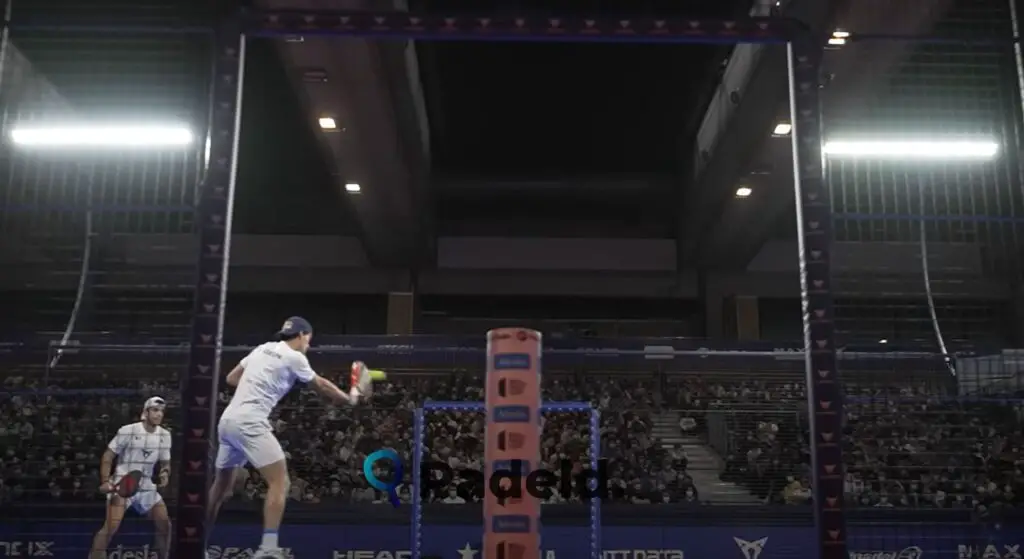
In addition to practicing volleys close to the net, make sure you move around the court and practice them from a bit further back, as well as from both sides of the court near the side glass. Getting comfortable hitting volleys from all angles should be your eventual goal.
Vary The Pace Of Your Shot
In any racket sport, employing a good amount of variation is key to outduelling your opponent. This is definitely the case in padel where it is often harder to hit winning shots than in a sport like tennis. By varying the speeds of our volleys, we can keep our opponents guessing, keep them off balance, and win more points as a result.
If your opponent presents you with opportunities to hit volleys, and on every single one you smash the ball back towards them as hard as you can, your opponent will start to get comfortable with this approach. When they get comfortable, they will begin to pre-empt your shots and will be able to get themselves in position to punish you with swift returns much more easily. However, if we vary the pace at which we hit our volleys, this means that it is impossible for our opponent to know for a fact what sort of a volley you are about to play. This means that they cannot mentally prepare themselves or move into position early to counter your shot.
A player with enormous power who tries to hit power volleys at every opportunity will be much less successful than a player who has slightly less power, but mixes up the pace of their volleys. So, during your practice sessions and practice matches, make sure you practice the power-based volleys such as the flat smash or the topspin smash, but also practice your light touch volleys that travel slowly towards the back of the court. Additionally, watch the behaviour of your opponents and try to think about when to use each volley, as there will be certain times that are more suited to both.
When your opponents think that you are about to play a powerful flat/topspin smash volley, they may move up towards the net to get an opportunity to hit the ball once it has rebounded off the back glass. If you spot them making this movement early, this is a great time to hit a slow-paced volley towards the back of the court. Hopefully when you play this shot the players that have advanced up towards the net will be too far away from the ball to reach it before it has bounced twice near the back glass.
Consider Allowing The Ball To Bounce In Certain Scenarios
A good padel player has to know when they are in a good position to play a shot. If we rush to play the volley every time the ball goes up in the air this could result in us playing the shot from a poor position, which can increase the risk of making mistakes and committing unforced errors. Sometimes, waiting an extra second or two and avoiding playing the volley, can mean that you hit a much better shot as a result. It will also reduce the number of mistakes you make while hitting volleys.
The more padel you play and the more times you hit volleys, the more you will become aware of what positions you need to be in to play effective shots. You will also be more aware of what poor volleying positions are, and will know when to avoid them. Playing lots of padel as well as other racket sports is simply the only way to develop this kind of experience and in-game knowledge, so make sure you’re getting out on court regularly!
A time when you may wish to allow the ball to bounce rather than volleying it is when the ball is dropping very close to the back wall of the court. When this is happening, you will have to position your body very close to the wall in order to volley it, and as a result you may even end up colliding with the wall. It is also much harder to hit a volley accurately from this far back on the court! In this situation, letting the ball bounce and allowing it to rebound off the glass before hitting a shot like the Bajada is a much better strategy.
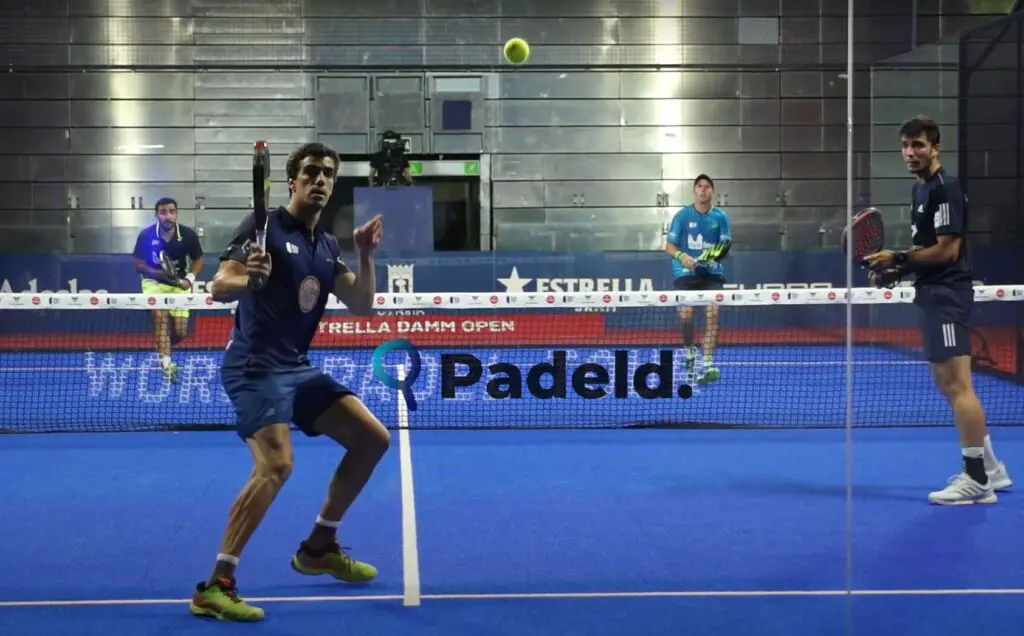
Conclusion
I hope that this post has given your plenty of ideas that you can use to improve the standard of your padel volleys. This is an incredibly important part of the game, and having a strong volley technique will mean that you’re better equipped to win a greater number of points and matches!
If you feel that volleying is a particularly weak area of your game, make sure you devote some time to practicing it using some of the methods I’ve provided in this post. When you work hard on a specific area of your game it’s remarkably easy to make improvements, so it’s definitely worth doing!
